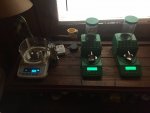Recently while searching through the internet I found a device that plugs into your A&D FX120i lab scale and turns it into an actual powder thrower. It's called the V2 Auto Trickler and it consists of a motor driven powder thrower, a connector cord for the thrower to connect to the scale, a few plastic "bands" that are used to give turn the trickler motor, a rubber tare holder for your powder pan, and a slide that adjusts how fast it actually throws your powder.
Heres how it operates. You use a scoop such as the yellow powder scoops that come with Lee die sets and get your charge weight set on the A&D. You then press a set button on the scale and it then programs your charge weight into the part of the scale that throws the powder.
After that you simply throw or pour ( using a charge master or a manual "scoop") powder onto a pan and pour it on to the A&D scale. It then throws the final charge in about 2 to 3 seconds. So if you're wanting to throw exactly 44.0 grains of powder you would place 42.5 or so onto the A&D and the trickler would automatically throw the remaining 1.5 grains and be within 2/100's of a grain.
This piece of equipment is nice if you're looking for exact tolerances on your charge weights however it does take a little more time because you're having to add to the pan that situated on the A&D scale. However, if you're looking for something that gets you dead nuts on your weight it's bad ass. They also make it for the Sartorious.
Heres the website.
http://www.autotrickler.com/index.html
Ive used it to load about a thousand rounds so far and have not had one issue with it.
Heres how it operates. You use a scoop such as the yellow powder scoops that come with Lee die sets and get your charge weight set on the A&D. You then press a set button on the scale and it then programs your charge weight into the part of the scale that throws the powder.
After that you simply throw or pour ( using a charge master or a manual "scoop") powder onto a pan and pour it on to the A&D scale. It then throws the final charge in about 2 to 3 seconds. So if you're wanting to throw exactly 44.0 grains of powder you would place 42.5 or so onto the A&D and the trickler would automatically throw the remaining 1.5 grains and be within 2/100's of a grain.
This piece of equipment is nice if you're looking for exact tolerances on your charge weights however it does take a little more time because you're having to add to the pan that situated on the A&D scale. However, if you're looking for something that gets you dead nuts on your weight it's bad ass. They also make it for the Sartorious.
Heres the website.
http://www.autotrickler.com/index.html
Ive used it to load about a thousand rounds so far and have not had one issue with it.



